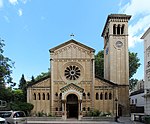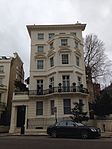Great Exhibition

The Great Exhibition of the Works of Industry of All Nations, also known as the Great Exhibition or the Crystal Palace Exhibition (in reference to the temporary structure in which it was held), was an international exhibition which took place in Hyde Park, London, from 1 May to 15 October, 1851. It was the first in a series of World's Fairs, exhibitions of culture and industry that became popular in the 19th century. The event was organised by Henry Cole and Prince Albert, husband of Victoria, Queen of the United Kingdom. Famous people of the time attended the Great Exhibition, including Charles Darwin, Karl Marx, Michael Faraday (who assisted with the planning and judging of exhibits), Samuel Colt, members of the Orléanist Royal Family and the writers Charlotte Brontë, Charles Dickens, Lewis Carroll, George Eliot, Alfred Tennyson and William Makepeace Thackeray. The opening music, under the superintendence of William Sterndale Bennett, was directed by Sir George Smart. The world's first soft drink, Schweppes, was the official sponsor of the event.
Excerpt from the Wikipedia article Great Exhibition (License: CC BY-SA 3.0, Authors, Images).Great Exhibition
New Ride, London Knightsbridge
Geographical coordinates (GPS) Address Nearby Places Show on map
Geographical coordinates (GPS)
| Latitude | Longitude |
|---|---|
| N 51.503055555556 ° | E -0.17 ° |
Address
The Great Exhibition 1851, Hyde Park
New Ride
SW7 1NR London, Knightsbridge
England, United Kingdom
Open on Google Maps










